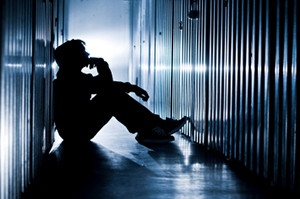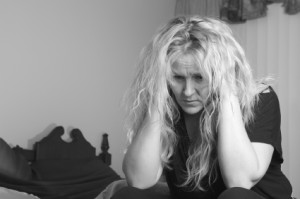- Calls to this hotline are currently being directed to Within Health, Fay or Eating Disorder Solutions
- Representatives are standing by 24/7 to help answer your questions
- All calls are confidential and HIPAA compliant
- There is no obligation or cost to call
- Eating Disorder Hope does not receive any commissions or fees dependent upon which provider you select
- Additional treatment providers are located on our directory or samhsa.gov
Which Came First? A Closer Look at the Relationship Between Bulimia and Depression/Anxiety
Contributors: Sandi Morse, LCSW is the Site Director and Kiersten Rapstine, LPC-S is the Clinical Supervisor at The Renfrew Center of Texas
 How do depression, anxiety and bulimia nervosa play-off of one another? In the complex relationship between the biological and psychosocial factors that create an eating disorder, it can be hard to determine which came first: the emotional pain or the behavior.
How do depression, anxiety and bulimia nervosa play-off of one another? In the complex relationship between the biological and psychosocial factors that create an eating disorder, it can be hard to determine which came first: the emotional pain or the behavior.
In this article we will describe the prevalence of bulimia along with depression and anxiety, explore the different theories and examine the treatment process.
The Prevalence of Bulimia
According to the National Eating Disorder Association, the incidences of bulimia have tripled in females ages 10-39 since the late 1980s. Bulimia, known clinically as bulimia nervosa, is the repeated cycle of out-of-control eating followed by some form of purging.
Symptoms of Purging
The purging associated with bulimia may be self-induced vomiting, excessive use of laxatives or diuretics or over-exercising. Those struggling with bulimia can experience the following medical complications:
- Inflammation and possible rupture of the esophagus
- Tooth decay
- Chronic irregular GI issues
- Irregular heartbeat
- Dehydration
- Loss of potassium and sodium resulting in possible heart failure and death
Mental Health Co-Occurring Disorders
 In addition to struggling with bulimia many also experience depression and anxiety. Research shows:
In addition to struggling with bulimia many also experience depression and anxiety. Research shows:
- Major Depressive Disorder affects about 7% of adults; 1 in 8 adolescents; and 1 in 33 children in the US. (Depression and Bipolar Support Alliance).
- Anxiety disorders affect about 18% of adults and 25% of adolescents. (National Institute of Mental Health).
- Those struggling with an eating disorder have a 50-70% higher risk also having depression and a 60-70% chance of having anxiety disorder
As clinicians we can sometimes be quick in trying to stabilize the eating disorder behaviors while simultaneously looking to increase tolerance of uncomfortable moods. Interestingly enough, the decrease in the bingeing and purging behavior increases the emotional discomfort like depression and anxiety.
Theories Addressing the Association Between Eating Disorders and Affective Disorders
There are multiple studies that address the association between eating disorders and affective disorders. Pertaining to bulimia along with depression and anxiety, the majority of research seems to conclude more often than not the negative affect symptoms precede the eating disorder behavior.
According to Heatherton and Baumesiter (1991) bulimic behaviors are a direct attempt at regulating mood. Specifically, bingeing is a way to escape and purging occurs as a way to cope with the depression and anxiety symptoms that resulted in consequence of bingeing. Finzi-Dottan and Zubery (2009) echoes this by stating that most bulimic patients struggle with confusion in their identity and have an overall unstable sense of self.
 The binge provides an escape from the self-awareness and the purging helps to tolerate the negative outcome. They further concluded that overall depression and anxiety increase symptoms of bulimia. They emphasize that bulimic symptomology is a regulatory mechanism and primarily a maladaptive coping skill.
The binge provides an escape from the self-awareness and the purging helps to tolerate the negative outcome. They further concluded that overall depression and anxiety increase symptoms of bulimia. They emphasize that bulimic symptomology is a regulatory mechanism and primarily a maladaptive coping skill.
The Difference Between Criteria and Traits of a Disorder
As clinicians, we argue, that the distinction is between what meets criteria for a disorder and what are simply symptoms or traits. For examples males or females may certainly (and oftentimes do) struggle with negative body image.
Perhaps in typical times of transition and identity confusion, there is increased dissatisfaction with appearance and/or weight. Of course, this could lead to increased depressive and anxiety symptoms.
Eating Disorders as Coping Mechanisms for Affective Disorders
However, as we know, not every person who struggles with concerns about his or her appearance develops a full blown eating disorder. We also know that depressive and anxiety disorders have several etiological mechanisms. The theory is that once someone develops a depressive or anxiety disorder the symptoms become so distressing that various, desperate coping mechanisms are investigated and attempted.
If the coping mechanism leads to control around food, you have the beginnings of what may become an eating disorder. If someone is using their bulimia to avoid, dampen, or even justify their depression/anxiety, and decreasing the eating disordered behavior is going to increase the already seemingly intolerable feelings… it’s easy to see how someone can feel very helpless to change.
Treatment for Eating Disorders with Anxiety and Depression
 Eating disorders are complex illnesses, which require equally complex treatment. At The Renfrew Center if a patient tries to argue their need to only address the anxiety and depression and later change their behaviors with food, we would be quick to discuss the holes in this approach.
Eating disorders are complex illnesses, which require equally complex treatment. At The Renfrew Center if a patient tries to argue their need to only address the anxiety and depression and later change their behaviors with food, we would be quick to discuss the holes in this approach.
Avoidance of the “triggers” that stir up ones emotional discomfort is not a way to get lasting control over the resulting moods. Imagine an individual receives a bad grade at school or an unfavorable review from their employer at work and their automatic response is to eat an entire chocolate cake and then self- induce vomit, they would have a difficult time changing their response to the feelings of disappointment, shame, anger etc. from the initial trigger. They are using their eating disorder to tolerate those feelings.
Responding to Emotional Troubles without Eating Disorder Behaviors
While decreasing and, hopefully, discontinuing the eating disorder behaviors will increase the feelings of emotional discomfort in the short term, the long term goal would be to respond to feelings of disappointment, anger, fear, sadness, etc. without the bulimic behaviors.
This will give the patient the best chance for lasting recovery and a sense of empowerment over both mood and behaviors. Another reason trying to make changes to decrease one’s depression and anxiety without decreasing the behaviors of bulimia is ineffective, is because there is no stable cognitive ground on which to stand.
Just as a child can’t learn on an empty stomach, a person with bulimia is “stuck” in a compromised place of mental functioning when they are actively binging and purging.
Dealing with the Guilt and Shame of an Eating Disorder, Compounding the Mental Health Problems
 Just as anxiety and depression impact bulimia, the reverse is also true. People struggling with bulimia often struggle with guilt and shame about being unable or unwilling to change their behaviors, as well as body image discomfort, fear around social eating situations, and isolation as a result of all of the above.
Just as anxiety and depression impact bulimia, the reverse is also true. People struggling with bulimia often struggle with guilt and shame about being unable or unwilling to change their behaviors, as well as body image discomfort, fear around social eating situations, and isolation as a result of all of the above.
To be able to change this “downward spiral,” there must be willingness to address behavior changes and tolerate moods that may have been part of their lives. So, is it even relevant to know which came first? Well, yes. Because every individual is different, every individual’s treatment plan will be different.
Any insights into an individual’s specific symptom history will help to bring insight to the therapeutic relationship and treatment. That said, ultimately what is most important is that there is no ‘which comes first’ in treatment modalities. The best chance for recovery in a patient with co-occurring disorders such as bulimia nervosa and depression anxiety is co-occurring treatment.
About the authors:
 Sandi Morse is the Site Director at the Renfrew Center of Texas. She received her Bachelor’s degree from Montclair State University in Music Therapy and Psychology and her Master’s degree in Social Work with a concentration in management from Fordham University. Ms. Morse is a Licensed Clinical Social Worker, Board Certified Music Therapist and Certified Yoga Teacher.
Sandi Morse is the Site Director at the Renfrew Center of Texas. She received her Bachelor’s degree from Montclair State University in Music Therapy and Psychology and her Master’s degree in Social Work with a concentration in management from Fordham University. Ms. Morse is a Licensed Clinical Social Worker, Board Certified Music Therapist and Certified Yoga Teacher.
She has worked in various healthcare settings for the last 14 years. Prior to joining Renfrew, she supervised an outpatient psychiatric program in New Jersey after working several years in a psychiatric hospital setting. She has served and continues to participate at The Renfrew Center in various ethics and performance improvement committees. Sandi enjoys running, yoga, spending time with friends and family and lives with her puppy Tarzan in Dallas.
 Kiersten Rapstine, LPC-S is the Clinical Supervisor at The Renfrew Center of Texas.
Kiersten Rapstine, LPC-S is the Clinical Supervisor at The Renfrew Center of Texas.
She trained in the treatment of co-occurring addictions and has worked with comorbid process addictions throughout her service in the mental health field for over ten years. She has worked at The Renfrew Center since the Texas site opened in 2008. Since then she has held the positions of Primary therapist, Team Leader and now is the Clinical Supervisor providing supervision to the clinicians and oversight of the clinical process to the site.
Kiersten has a passion for helping those with eating disorders as well as working to increase awareness in the community. She has presented and educated about eating disorders in multiple settings including colleges, teachers groups and mental health practices in the DFW area.
Community Discussion – Share your thoughts here!
What has been your experience with Bulimia and Depression/Anxiety, which do you believe came first and how has addressing both impacted your recovery?
Bibliography:
- Finzi-Dottan, R. & Zubery,E. “ The Role of Depression and Anxiety in Impulsive and Obsessive-Compulsive Behaviors Among Anorexic and Bulimic Patients.” Eating Disorders 17. 2009: 162-182
- Heatherton, T.F. & Baumeister, R.F. “Binge Eating as Escape from Self-Awareness.” Psychological Bulletin 110 1997: 86-108.
- Marmorstein, Naomi, et al. “Prospective Associations Between Depressive Symptoms and Eating Disorder Symptoms Among Adolescent Girls.” International Journal of Eating Disorders 41:2 2008: 118-123.
Last Updated & Reviewed By: Jacquelyn Ekern, MS, LPC on June 2nd, 2015
Published on EatingDisorderHope.com

